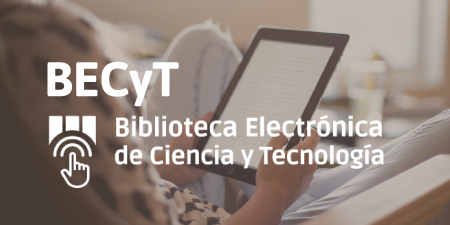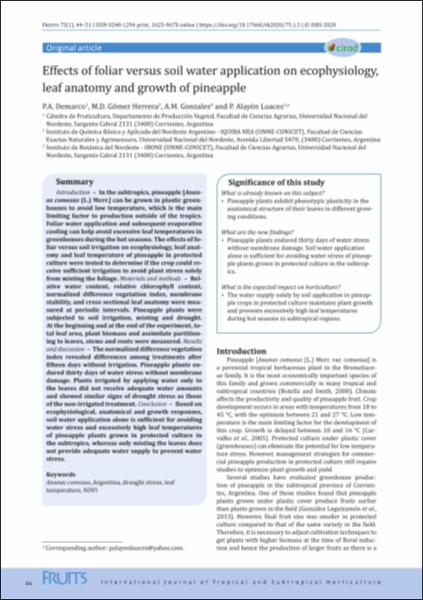Mostrar el registro sencillo del ítem
Effects of foliar versus soil water application on ecophysiology, leaf anatomy and growth of pineapple
| dc.contributor.author | Demarco, Paula Andrea | |
| dc.contributor.author | Gómez Herrera, Melanie Desirée | |
| dc.contributor.author | González, A. M. | |
| dc.contributor.author | Alayón Luaces, Paula | |
| dc.date.accessioned | 2024-03-14T12:26:01Z | |
| dc.date.available | 2024-03-14T12:26:01Z | |
| dc.date.issued | 2020 | |
| dc.identifier.citation | Demarco, Paula, et al., 2020. Effects of foliar versus soil water application on ecophysiology, leaf anatomy and growth of pineapple. Fruits. Paris: EDP Sciences, vol. 75, no. 1, p. 44-51. E-ISSN 1625-967X. | es |
| dc.identifier.issn | 0248-1294 | es |
| dc.identifier.uri | http://repositorio.unne.edu.ar/handle/123456789/53137 | |
| dc.description.abstract | In the subtropics, pineapple [Anan- as comosus (L.) Merr.] can be grown in plastic green- houses to avoid low temperature, which is the main limiting factor to production outside of the tropics. Foliar water application and subsequent evaporative cooling can help avoid excessive leaf temperatures in greenhouses during the hot seasons. The effects of fo- liar versus soil irrigation on ecophysiology, leaf anat- omy and leaf temperature of pineapple in protected culture were tested to determine if the crop could re- ceive sufficient irrigation to avoid plant stress solely from misting the foliage. Materials and methods – Rel- ative water content, relative chlorophyll content, normalized difference vegetation index, membrane stability, and cross sectional leaf anatomy were mea- sured at periodic intervals. Pineapple plants were subjected to soil irrigation, misting and drought. At the beginning and at the end of the experiment, to- tal leaf area, plant biomass and assimilate partition- ing to leaves, stems and roots were measured. Results and discussion – The normalized difference vegetation index revealed differences among treatments after fifteen days without irrigation. Pineapple plants en- dured thirty days of water stress without membrane damage. Plants irrigated by applying water only to the leaves did not receive adequate water amounts and showed similar signs of drought stress as those of the non-irrigated treatment. Conclusion – Based on ecophysiological, anatomical and growth responses, soil water application alone is sufficient for avoiding water stress and excessively high leaf temperatures of pineapple plants grown in protected culture in the subtropics, whereas only misting the leaves does not provide | es |
| dc.format | application/pdf | es |
| dc.format.extent | p. 44-51 | es |
| dc.language.iso | eng | es |
| dc.publisher | EDP Sciences | es |
| dc.rights | openAccess | es |
| dc.rights.uri | http://creativecommons.org/licenses/by-nc-nd/2.5/ar/ | es |
| dc.source | Fruits, 2020, vol. 75, no. 1, p. 44-51. | es |
| dc.subject | Ananas comosus | es |
| dc.subject | Argentina | es |
| dc.subject | Drought stress | es |
| dc.subject | Leaf temperature | es |
| dc.subject | NDVI | es |
| dc.title | Effects of foliar versus soil water application on ecophysiology, leaf anatomy and growth of pineapple | es |
| dc.type | Artículo | es |
| unne.affiliation | Fil: Demarco, Paula Andrea. Universidad Nacional del Nordeste. Facultad de Ciencias Agrarias; Argentina. | es |
| unne.affiliation | Fil: Gómez Herrera, Melanie Desirée. Universidad Nacional del Nordeste. Facultad de Ciencias Exactas Naturales y Agrimensura; Argentina. | es |
| unne.affiliation | Fil: Gómez Herrera, Melanie Desirée. Consejo Nacional de Investigaciones Científicas y Técnicas. Instituto de Química Básica y Aplicada del Nordeste Argentino; Argentina. | es |
| unne.affiliation | Fil: González, A. M. Universidad Nacional del Nordeste. Facultad de Ciencias Agrarias; Argentina. | es |
| unne.affiliation | Fil: González, A. M. Consejo Nacional de Investigaciones Científicas y Técnicas. Instituto de Botánica del Nordeste; Argentina. | es |
| unne.affiliation | Fil: Alayón Luaces, Paula. Universidad Nacional del Nordeste. Facultad de Ciencias Agrarias; Argentina. | es |
| unne.journal.pais | Francia | es |
| unne.journal.ciudad | Paris | es |
| unne.journal.volume | 75 | es |
| unne.journal.number | 1 | es |
| unne.ISSN-e | 1625-967X | es |
Ficheros en el ítem
Este ítem aparece en la(s) siguiente(s) colección(ones)
-
Artículos de revista [479]





